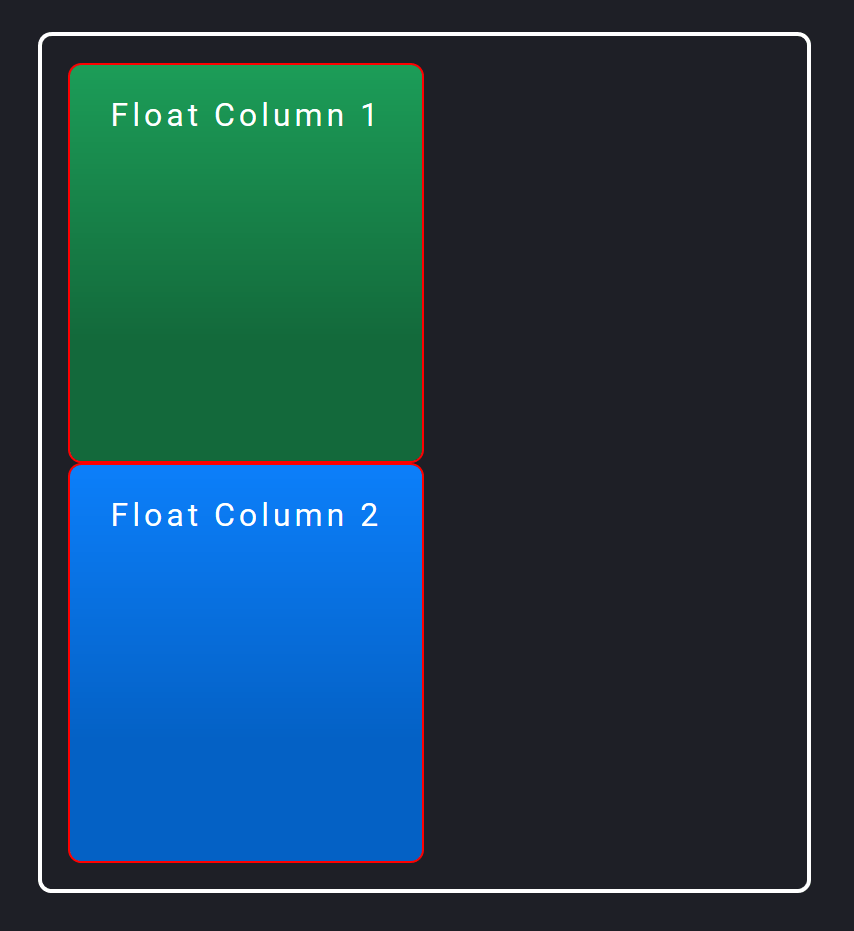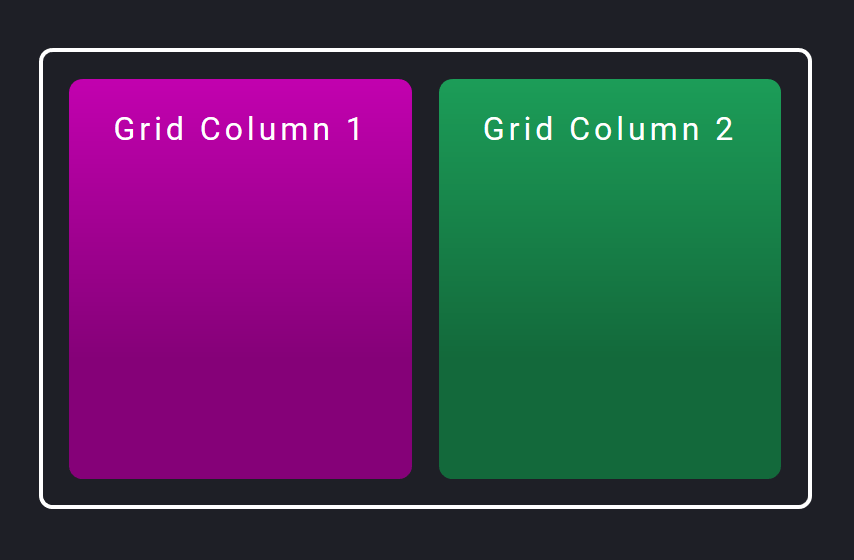Small 2 Fan Side by Side Window Fan
Here are 3 slipway you can use CSS to place HTML div elements English by sidelong.
(Click to jump to to each one section)
- Float method
- Flexbox method
- CSS grid method
Float Method
In the float method, we will be using the following HTML markup:
<div class="float-container"> <div course="float-tiddler"> <div form="green">Float Column 1</div> </div> <div sort="drift-minor"> <div class="blue">Float Newspaper column 2</div> </div> </div> The.ice-cream soda-container is simply the nurture element that contains some.float-shaver elements.
To amaze the divs side aside face, we will use the tailing CSS rules:
.float-container { border: 3px solid #fff; padding: 20px; } .float-shaver { width: 50%; drift: left; padding: 20px; adjoin: 2px solid red; } The resulting code testament look on like this:

I've added borders and padding to the divs then you can many easily see exactly what's passing on. The thicker solid white approach the outside is the.float-container div, which has 20px of cushioning.
So from each one.float-child element has a thinner blood-red border and some more padding. Then the actual color blocks are child elements of the.float-child elements. (You'll see wherefore in a bit.)
To position the divs side by side, we are using thefloat property to float each.float-child element to the left.
Since they are some floating to the left, they will expose related to if there's enough space for both to fit. They do burst because we get two.float-child divs, each at 50% breadth.
And the distance betwixt the divs is created by adding padding in each.float-nipper div, which and so contains the color blocks.
Add space between columns by nesting each column in an outer div
It's necessary for the color blocks to have an outer div (.float-tike) systematic to lend space and as wel have some blocks fit side by side.
Well, what if we only had the.float-child divs without padding, and or else tried to add space by putting amargin-right value happening the first impede like this?
HTML:
<div class="ice-cream float-container"> <div class="blow-tiddler ill"> Ice-cream soda Column 1 </div> <div family="float-child blue"> Float Column 2 </div> </div> CSS:
.float-baby.light-green { margin-right: 20px; } In that case, some.float-child elements would lift out 50% of the tote up width. But the first green factor would also have a edge of 20px.
This would mean that both blocks would choose up 50% + 20px + 50% breadth. This would be 20px more than 100% width, meaning there's not enough room for both to be side by side.
The second blue block would then wrapper to the incoming wrangle underneath the initiatory block, and float to the left there:

You give notice hear to fine-tune the widths so they are 48% or some other figure to a lesser degree 50% to fit them. But it won't be mathematical.
That's why I personally like wrapping the blocks in an outer div set at 50% width, with padding to add the place between the divs.
Nowadays, it's easier to habit otherwise, newer methods in CSS to place divs side by side rather than with drift.
Let's get a load at one of these: the flexbox method!
Flexbox Method
With flexbox, we privy use a more self-generated way of aligning our two div elements.
HTML:
<div class="flex-container"> <div class="flex-child magenta"> Deform Column 1 </div> <div class="flex-fry green"> Flex Column 2 </div> </div> CSS:
.deform-container { display: flex; } .twist-child { flex: 1; adjoin: 2px solid state chickenhearted; } .turn-child:first-class honours degree-youngster { margin-appropriate: 20px; } With flexbox, we have setdisplay: deform on the raise.flex-containerelement. This turns on flexbox.
Then in each.flex-nestling constituent, we are settingflex: 1. This number is like a ratio comparing the widths of each child in the parent flex element.
Since they are the same, the available blank space volition beryllium divided upwards every bit. And since we have cardinal tyke elements, they volition all seize on 50%.
Here's what the resulting code wish look ilk:

Summate space between divs by victimization a margin, and information technology wish still fit!
Notice that we've added space by addingmargin-right: 20px to just the first.flex-child element. However, flexbox is intelligent enough to take that extra 20px into considerateness when dividing raised the residue of the gettable width.
This substance you can minimal brain dysfunction space with margin without having to calculate the exact pixels. Flexbox will fit the contentedness for you!
This is one big reason that I love flexbox.
However, if you have multiple elements that you want to layout in a religious music grid, you don't always know where you need to add that space between elements.
In our case, if we wanted to stack the two divs one under the other for mobile, we would have to take come out of the closet thatmargin-right property for mobile widths.
Operating theatre you could add an additional satellite element plus padding for apiece.twist-child element, similar to what we did with the blow method.
It's not 100% intuitive, but it will stillness work. If you need to create Thomas More complex responsive layouts with flexbox, you wish need to keep this in mind.
Let's now drive a spirit at the newest method you seat use to place divs side by side of meat: CSS grid.
CSS Grid Method acting
And here's how you can put on the two divs slope by pull, using CSS grid:
HTML:
<div class="grid-container"> <div class="gridiron-child purpleness"> Reference grid Column 1 </div> <div class="grid-child green"> Grid Column 2 </div> </div> CSS:
.grid-container { display: grid; reference grid-template-columns: 1fr 1fr; grid-gap: 20px; } And here's what the code testament look like:

One overlarge change with grid is that you first determine what the grid templet will look like. Meaning how many another columns and/Oregon rows you want in your layout.
In our case, we want two columns of equal width. So in the parent.grid-container component, we turn grid on withdisplay: grid. Then we add in how umteen columns we want in our layout with thegrid-guide-columns property.
We want two columns of equal width, so we lay out it to1fr 1fr. This tells the browser to create a two-column layout, and each column takes up1fr (fr = fractional whole) of space.
The fr social unit is a ratio of each column to some other, replaceable to theflex: 1 rule we used in the flexbox method. Having the columns set to1fr 1fr way that each pillar will take up the same amount of space.
Adding space between grid items with the grid-gap property
One big benefit to using CSS grid is that you don't pauperism to use padding or margin to add space between grid items.
You can usage thegrid-gap (orgap in newer browsers) to automatically impart space in your grid template.
We've setpower grid-gap to 20px, so the browser will know to sum up 20px of space betwixt all items, whether they are side by side or stacked.
And you may have noticed that all the CSS properties for reference grid were assail the parent.grid-container element. We didn't actually have to write out any CSS for the child.power grid-child elements!
Small 2 Fan Side by Side Window Fan
Source: https://coder-coder.com/display-divs-side-by-side/
